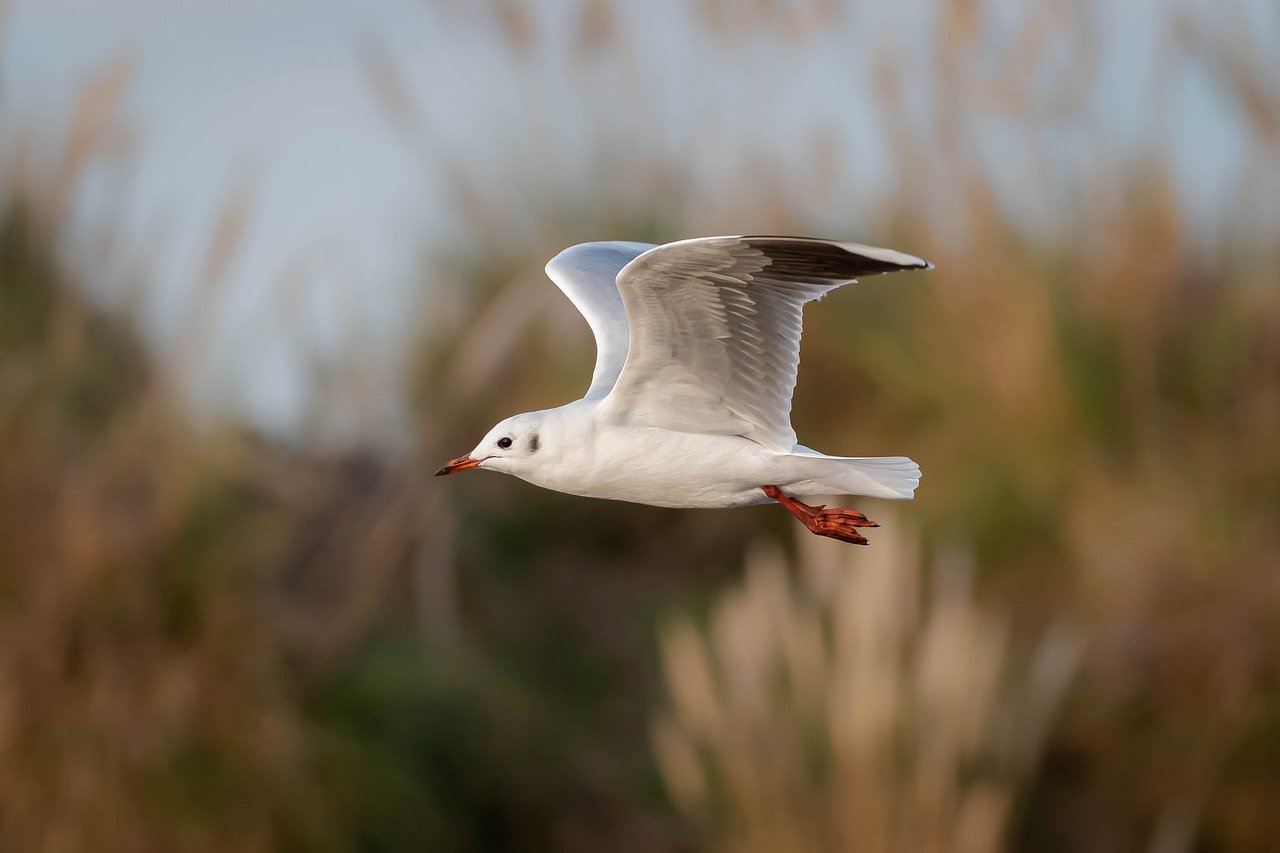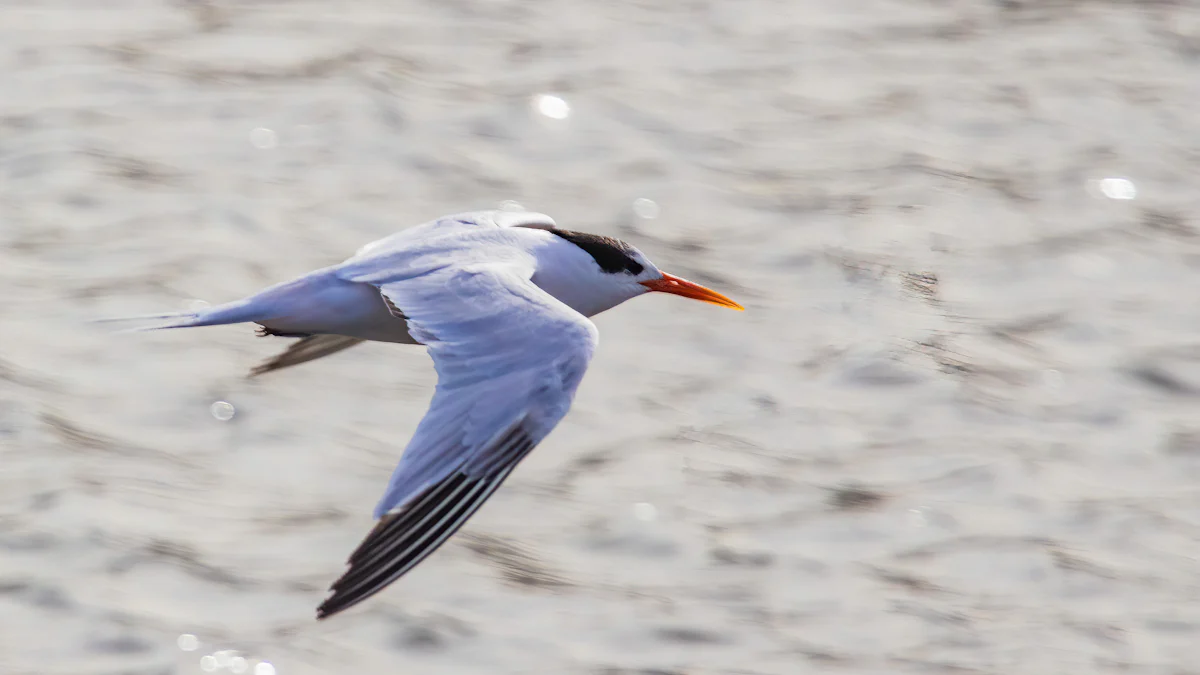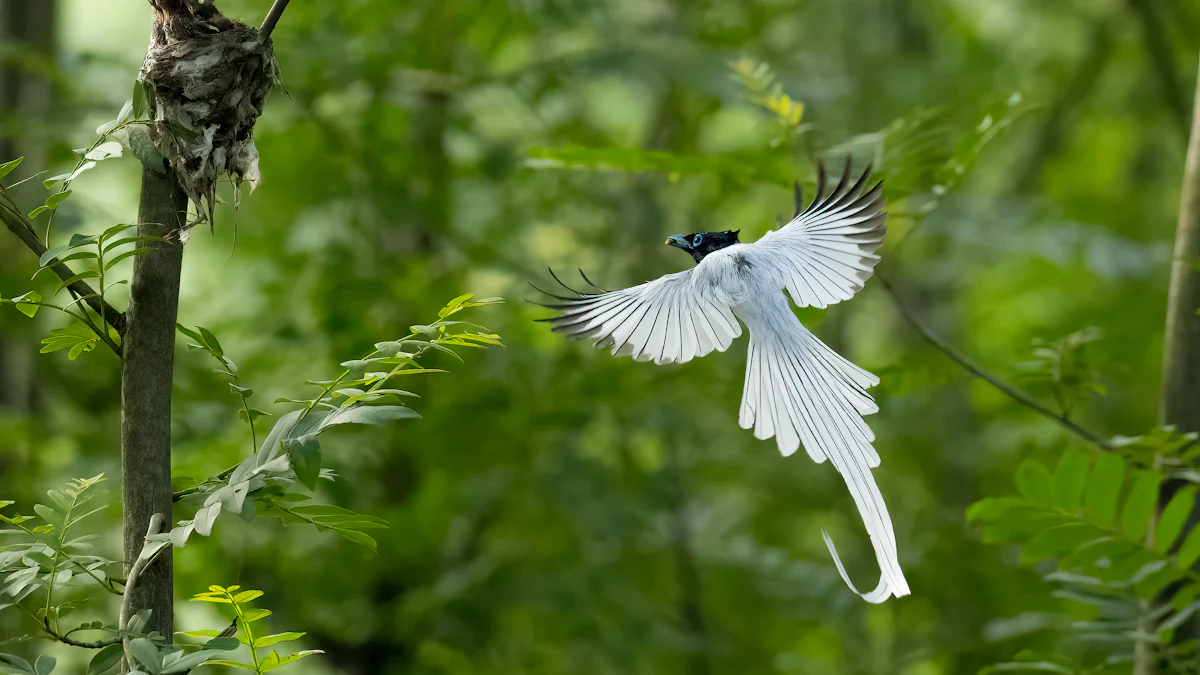
Understanding how bird wings fold during flight reveals the marvel of nature's engineering. When birds fold their wings, they achieve a remarkable 40% reduction in drag, enhancing flight efficiency. This folding mechanism involves precise movements of joints and muscles, allowing birds to streamline their bodies. As you observe birds in flight, notice how they fold their wings during the upstroke to minimize drag. This action not only conserves energy but also improves maneuverability, enabling birds to navigate their environment with grace and agility.
Key Takeaways
Birds achieve a 40% reduction in drag by folding their wings, enhancing flight efficiency and conserving energy.
The intricate structure of bird wings, including bones, joints, and muscles, allows for precise folding and unfolding during flight.
Wing folding minimizes air resistance, enabling birds to maintain higher speeds and prolong their flight duration, especially during migration.
Different bird species exhibit unique wing folding mechanics, adapted to their environments and flight styles, from soaring eagles to agile songbirds.
The study of bird wing folding inspires technological advancements in aviation and robotics, leading to more efficient aircraft and drones.
Understanding the mechanics of wing folding can enhance our appreciation for avian adaptations and inform future innovations in engineering.
Anatomy of Bird Wings

Understanding the anatomy of bird wings provides insight into how bird wings fold during flight. The structure of bird wings is a marvel of nature, designed for both strength and flexibility.
Structure of Bird Wings
Bones and Joints
Bird wings consist of a complex arrangement of bones and joints. The primary bones include the humerus, radius, and ulna. These bones form the framework that supports the wing. Joints, such as the shoulder, elbow, and wrist, allow for the necessary range of motion. The shoulder joint enables rotation, while the elbow and wrist joints facilitate folding. This articulated skeleton is crucial for the dynamic movements required during flight.
Muscles Involved
Muscles play a vital role in wing movement. The pectoralis muscles, located in the chest, are responsible for the powerful downstroke. These muscles are well-suited for producing large movements. Intrinsic wing muscles, which are short-fibered and pinnate, control the finer movements of the wing. They allow for precise adjustments during flight, ensuring efficient wing folding and unfolding.
Key Components in Wing Folding
Primary and Secondary Feathers
Feathers are essential for flight. Primary feathers, located at the wing's tip, provide thrust and lift. Secondary feathers, found closer to the body, help maintain stability. When birds fold their wings, these feathers overlap neatly. This overlapping reduces the wing's surface area, minimizing drag and enhancing aerodynamic performance.
Role of Tendons and Ligaments
Tendons and ligaments support the wing's structure. Tendons connect muscles to bones, transmitting the force needed for movement. Ligaments stabilize the joints, ensuring smooth and controlled folding. Together, they enable the precise coordination required for effective wing folding. This coordination allows birds to streamline their bodies, improving flight efficiency and maneuverability.
Mechanics of How Bird Wings Fold
Understanding how bird wings fold involves examining the intricate muscle movements and the precise sequence of actions that occur during flight. This process is a testament to nature's engineering, allowing birds to achieve both power and control in their flight.
Muscle Movements
Contraction and Relaxation
Muscles in a bird's wing work in harmony to facilitate folding. The contraction and relaxation of these muscles are crucial. When you observe a bird in flight, notice how the muscles contract to pull the wings inward. This action reduces the wing's span, making it more compact. Relaxation follows, allowing the wings to extend again. This cycle of contraction and relaxation is continuous, enabling smooth transitions between different phases of flight.
Coordination of Muscle Groups
The coordination of muscle groups is essential for effective wing folding. Over 50 muscles work together to achieve this. Each muscle group has a specific role, ensuring that the wings fold and unfold seamlessly. This coordination allows birds to adjust their wing shape and position, optimizing their flight performance. Studies have shown that this muscle function is vital for achieving both power and control in avian flight.
Sequence of Movements
Folding and Unfolding Process
The folding and unfolding process of bird wings is a complex sequence of movements. Initially, the shoulder joint rotates, bringing the wing closer to the body. The elbow and wrist joints then fold, tucking the wing neatly. This sequence minimizes the wing's surface area, reducing drag. When unfolding, the process reverses, with the joints extending to restore the wing's full span. This precise sequence is crucial for maintaining aerodynamic efficiency.
Timing and Precision
Timing and precision are key in how bird wings fold. Birds must execute these movements with exact timing to ensure efficient flight. The folding occurs primarily during the upstroke, minimizing drag and conserving energy. Precision in timing allows birds to navigate their environment with agility. Research into wing morphing mechanisms inspired by bird feathers highlights the importance of timing in achieving aerodynamic advantages.
Aerodynamic Benefits of Wing Folding in Bird Flight
Birds have mastered the art of flight through the evolution of their wings. One of the key advantages of wing folding is its aerodynamic benefits, which significantly enhance bird flight.
Reduced Drag
Streamlining the Body
When birds fold their wings, they streamline their bodies. This action reduces the wing's surface area, allowing birds to move through the air with less resistance. By tucking their wings close to their bodies, birds create a sleek profile. This streamlined shape helps them cut through the air more efficiently. You can observe this in birds like falcons and swifts, which fold their wings tightly during high-speed dives.
Minimizing Air Resistance
Minimizing air resistance is crucial for efficient flight. Birds achieve this by folding their wings during certain phases of flight, such as the upstroke. This folding reduces drag, allowing birds to conserve energy. The ability to minimize air resistance is particularly important for migratory birds, which travel long distances. By reducing drag, these birds can maintain higher speeds with less effort.
Energy Conservation
Efficient Use of Energy
Wing folding plays a vital role in conserving energy during flight. By reducing drag, birds use less energy to maintain their speed and altitude. This efficiency is essential for birds that need to fly long distances without stopping. For example, albatrosses can glide over vast ocean expanses by folding their wings to reduce drag and conserve energy.
Prolonged Flight Duration
Energy conservation through wing folding allows birds to prolong their flight duration. Birds with foldable wings can travel greater distances without tiring. This adaptation is especially beneficial for species that migrate across continents. By folding their wings, birds optimize their energy use, enabling them to reach their destinations with minimal fatigue.
Variations in Wing Folding Among Bird Species

Birds exhibit a fascinating diversity in wing folding, reflecting their adaptation to different environments and lifestyles. As you explore the variations in wing folding among bird species, you'll discover how these adaptations enhance their survival and efficiency in flight.
Different Wing Types
Broad vs. Narrow Wings
Birds possess wings that vary in width, influencing their flight capabilities. Broad wings, like those of eagles and vultures, provide excellent lift and are ideal for soaring. These wings allow birds to glide effortlessly, conserving energy over long distances. In contrast, narrow wings, seen in swifts and falcons, enable rapid, agile flight. These birds excel in high-speed pursuits, using quick wingbeats to maneuver through the air with precision.
Adaptations for Specific Environments
Birds have evolved wing structures suited to their habitats. For instance, penguins have short, stiff wings adapted for swimming rather than flying. Their wing bones are fused, preventing folding but providing strength for underwater propulsion. In contrast, forest-dwelling birds like woodpeckers have wings that allow for quick, vertical takeoffs and landings among trees. These adaptations highlight the remarkable ways birds have evolved to thrive in diverse environments.
Species-Specific Folding Mechanics
Raptors vs. Songbirds
Raptors, such as hawks and eagles, exhibit powerful wing folding mechanics. Their wings fold tightly against their bodies, reducing drag during high-speed dives. This ability enhances their hunting efficiency, allowing them to capture prey with precision. Songbirds, on the other hand, have more flexible wings that facilitate rapid flapping and maneuverability. Their wing folding supports quick changes in direction, essential for navigating dense foliage and avoiding predators.
Waterfowl vs. Land Birds
Waterfowl, like ducks and geese, have wings adapted for both flying and swimming. Their wings fold compactly, aiding in streamlined movement through water. This dual functionality allows them to transition seamlessly between air and water. Land birds, such as sparrows and robins, rely on wing folding for efficient terrestrial navigation. Their wings fold neatly, enabling them to forage and move swiftly on the ground.
By understanding these variations in wing folding, you gain insight into the incredible adaptability of birds. Each species has evolved unique wing structures and folding mechanics to optimize their flight performance and survival in their respective environments.
Technological Implications of Wing Folding
Birds have inspired many technological advancements, especially in aviation and engineering. Their ability to fold wings efficiently has led to innovative designs and concepts in various fields.
Inspiration for Aviation Design
Aircraft Wing Design
You might wonder how bird wings influence aircraft design. Engineers study the folding mechanism of bird wings to create more efficient aircraft wings. By mimicking the way birds fold their wings, designers can develop wings that adjust during flight. This adaptability improves fuel efficiency and performance. For instance, some aircraft now feature wings that can change shape mid-flight, similar to how birds adjust their wings to optimize flight.
Drones and Robotics
Drones and robotics also benefit from the study of bird wing folding. Researchers at MIT are exploring flexible wings made of scale-like modular structures. These structures allow drones to maneuver more effectively, much like birds do in the air. By incorporating these flexible designs, drones can achieve better stability and control, making them more versatile in various environments.
Biomimicry in Engineering
Applications in Technology
Biomimicry, the practice of drawing inspiration from nature, plays a significant role in engineering. The folding mechanism of bird wings offers valuable insights for technological applications. Engineers use these principles to design more efficient machines and devices. For example, morphing wings, inspired by birds, are being developed for micro air vehicles. These wings can change shape to improve flight capabilities, allowing for greater agility and efficiency.
Future Innovations
Looking ahead, the potential for innovations inspired by bird wing folding is vast. As technology advances, engineers continue to explore new ways to incorporate these natural mechanisms into modern designs. Future innovations may include more advanced drones and aircraft that mimic the precise movements of bird wings. These developments could lead to breakthroughs in energy efficiency and performance, revolutionizing how we approach flight and mobility.
Understanding how bird wings fold offers valuable insights into both nature and technology. You have learned that the folding motion, combined with the wing’s passive torsional deformation, significantly influences flight performance. This knowledge is crucial for designing flapping-wing mechanisms in aviation. By observing birds, you gain a deeper appreciation for their remarkable adaptations. These insights not only enhance your understanding of avian morphology but also inspire innovations in engineering and design. As you continue exploring, consider how these natural mechanisms can inform future technological advancements.
FAQ
Do all birds of the same species fold their wings the same way?
Not all birds fold their wings in the same manner. Generally, birds like raptors and ocean birds, such as gulls and albatrosses, have long wings that allow for folding. However, variations exist even within species. Some birds may have adaptations that influence how they fold their wings, depending on their environment and lifestyle.
How do birds regain mobility through the structure of their wings?
Birds possess highly mobile shoulder joints, which grant them a greater range of motion than humans. Imagine being able to clap your hands behind your back with fully extended arms. This hypermobility allows birds to change the shape of their wings and control dynamic flight. The folding and unfolding of the wings, combined with this shoulder flexibility, enable birds to maneuver with precision.
Why is wing folding important for birds during flight?
Wing folding plays a crucial role in reducing drag and conserving energy. By folding their wings during certain phases of flight, birds streamline their bodies, minimizing air resistance. This efficiency allows them to fly longer distances without expending excessive energy. Wing folding also enhances maneuverability, enabling birds to navigate their environment with agility.
What role do feathers play in wing folding?
Feathers, particularly primary and secondary ones, are essential for wing folding. When birds fold their wings, these feathers overlap neatly, reducing the wing's surface area. This overlapping minimizes drag and enhances aerodynamic performance. Feathers not only provide lift and thrust but also contribute to the precise folding mechanism that optimizes flight.
Can wing folding inspire technological advancements?
Yes, the study of bird wing folding has inspired innovations in aviation and engineering. Engineers mimic the folding mechanism of bird wings to design more efficient aircraft and drones. By incorporating flexible wing designs, these technologies achieve better stability and control. Biomimicry, drawing inspiration from nature, continues to influence future innovations in various fields.
How do different environments affect wing folding in birds?
Birds have evolved wing structures suited to their habitats. For example, penguins have short, stiff wings adapted for swimming, while forest-dwelling birds like woodpeckers have wings that allow for quick takeoffs among trees. These adaptations highlight how birds have evolved to thrive in diverse environments, each with unique wing folding mechanics.
What is the significance of timing in wing folding?
Timing is crucial in wing folding, as birds must execute movements with precision to ensure efficient flight. Folding primarily occurs during the upstroke, minimizing drag and conserving energy. Precise timing allows birds to navigate their environment with agility, enhancing their ability to respond to changing conditions and obstacles.
How do tendons and ligaments support wing folding?
Tendons and ligaments play a vital role in supporting the wing's structure. Tendons connect muscles to bones, transmitting the force needed for movement, while ligaments stabilize the joints. Together, they enable the precise coordination required for effective wing folding, allowing birds to streamline their bodies and improve flight efficiency.
Are there differences in wing folding between raptors and songbirds?
Yes, raptors and songbirds exhibit different wing folding mechanics. Raptors, like hawks and eagles, fold their wings tightly against their bodies, reducing drag during high-speed dives. This ability enhances their hunting efficiency. Songbirds, however, have more flexible wings that support rapid flapping and maneuverability, essential for navigating dense foliage.
How does wing folding contribute to energy conservation in birds?
Wing folding reduces drag, allowing birds to use less energy to maintain speed and altitude. This efficiency is crucial for birds that fly long distances, such as migratory species. By folding their wings, birds optimize their energy use, enabling them to travel greater distances without tiring, thus prolonging their flight duration.
In conclusion, understanding how bird wings fold for flight not only deepens our appreciation for these incredible creatures but also enhances our birdwatching experience. As you observe their fascinating flight mechanics, consider providing them with the best feeding opportunities. Our smart bird feeders are designed to attract a wide variety of birds while keeping their food fresh and accessible. Explore our products today and elevate your backyard birding adventure!













